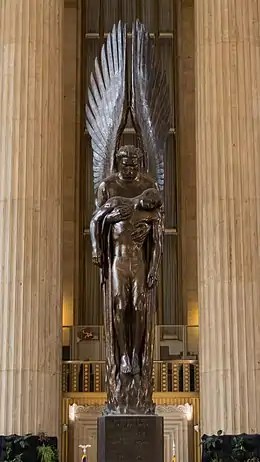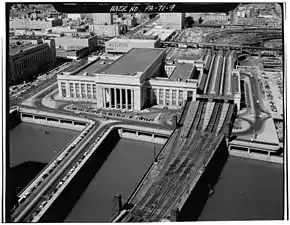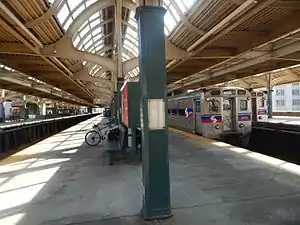30th Street Station
30th Street Station, officially William H. Gray III 30th Street Station, is an intermodal transit station in Philadelphia, Pennsylvania. It is the metropolitan area's main railroad station, and is a major stop on Amtrak's Northeast and Keystone corridors. It doubles as a major commuter rail station; it is served by all Southeastern Pennsylvania Transportation Authority (SEPTA) Regional Rail lines, and is the western terminus for NJ Transit's Atlantic City Line. It is also served by several SEPTA city and suburban buses, as well as buses operated by NJ Transit and intercity operators.
The station, which served more than 4 million inter-city rail passengers in 2018, is Amtrak's third-busiest, after Penn Station in Manhattan and Union Station in Washington, D.C.,[8] and North America's 12th-busiest train station overall.
Description
The station is located at 2955 Market Street.[1] It is located in Philadelphia's University City neighborhood, just across the Schuylkill River from Center City. The building, which first opened in 1933, is listed on the National Register of Historic Places.
Amtrak's code for the station is PHL.[1] Its IATA Airport Code is ZFV on United because Amtrak's service to Newark Liberty International Airport is codeshared with United Airlines.
30th Street Station is Amtrak's third-busiest station, and by far the busiest of the 24 stations served in Pennsylvania, serving 4,411,662 passengers in fiscal year 2017. On an average day in fiscal 2013, about 12,000 people boarded or left trains in Philadelphia, nearly twice as many as in the rest of the Pennsylvania stations combined.[9]
History


The Pennsylvania Railroad (PRR), which was headquartered in Philadelphia, acquired tunnel rights from the Schuylkill River to 15th Street from the city of Philadelphia in return for land that the city needed to construct the Benjamin Franklin Parkway. This allowed the company to build both Suburban Station and the 30th Street Station,[10] which replaced Broad Street station as the latter was too small. Broad Street Station was a stub-end terminal in Center City and through trains had to back in and out, and the company wanted a location which would accommodate trains between New York City and Washington. D.C. Broad St. station also handled a large commuter operation, which the new underground Suburban Station was built to handle. (Because of the Depression and World War II, Broad St. station didn't close until 1952.)[11]
The Chicago architectural firm of Graham, Anderson, Probst and White, the successor to D.H. Burnham & Company,[10] designed the structure, originally known as Pennsylvania Station–30th Street in accord with the naming style of other Pennsylvania Stations. Its design was influenced by the Northeast Corridor electrification that allowed trains to pass beneath the station without exposing passengers to soot as steam engines of earlier times had. The station had a number of innovative features, including a pneumatic tube system, an electronic intercom, and a reinforced roof with space for small aircraft to land,[12] and contained a mortuary, a chapel and more than 3,000 square feet of hospital space.[10]
Construction began in 1927 and the station opened in 1933, starting with two platform tracks.[5] The vast waiting room is faced with travertine and the coffered ceiling is painted gold, red and cream. The building's exterior has columned porte-cocheres on the west and east facade, and shows a balance between classical and modern architectural styles.[10]
Until 1958, 30th Street Station was one of two major intercity stations in Philadelphia, the other being the Baltimore & Ohio Railroad's station on Chestnut Street. However, when the B&O ended all service north of Baltimore in 1958, 30th Street became the major intercity terminal in the Delaware Valley.
In the 1970s, Amtrak installed a Solari board (by Solari di Udine) in the main waiting room to display train departure information. On November 30, 2018, officials announced that the board — by then, the railroad's last remaining Solari device — would be replaced with a digital board.[13][14] A minor public outcry followed, and within days, Rep. Brendan Boyle urged Amtrak CEO Richard H. Anderson to reconsider.[14][15][16] In January 2019, Amtrak sent the board to the Railroad Museum of Pennsylvania in Strasburg, reserving the right to reclaim it if it could be worked into the station's planned renovation.[17] On February 28, 2019, the new digital board began operation.[18] The Museum placed the Solari board on static display in July 2019; its ultimate fate remains undecided.[19]
Ben Franklin Station
In 2005, Philadelphia-based Pew Charitable Trust asked Amtrak to change the name of 30th Street Station to "Ben Franklin Station"[20] as part of the celebration of Ben Franklin's 300th birthday in January 2006. The cost of replacing signs at the station was estimated at $3 million.
In January, Philadelphia Mayor John Street threw his support behind the name change, but others had mixed reactions to the proposal. Pennsylvania Governor Ed Rendell, a former mayor of Philadelphia, was lukewarm, while Amtrak officials worried that a "Ben" station could be confused with its other three "Penn" stations.[21] On January 25, 2006, Pew abandoned the campaign, giving no reason.[21]
Renaming
In August 2014, Congress passed a law to rename the station to William H. Gray III 30th Street Station in honor of the late congressman.[22] At the time, the change was to occur "in the next few months".[23] In 2019, signs were installed outside the station with the new name and plans were announced for a statue of Gray and a memorial plaque.[24] The name change officially took effect on February 6, 2020.[25]
Present day
The building is owned by Amtrak and houses many Amtrak corporate offices, although Amtrak is officially headquartered near Union Station in Washington, D.C. The 562,000 ft² (52,000 m²) facility features a cavernous main passenger concourse with ornate Art Deco decor.

Prominently displayed is the Pennsylvania Railroad World War II Memorial, which honors Pennsylvania Railroad employees killed in World War II. It consists of a bronze statue of the archangel Michael lifting the body of a dead soldier out of the flames of war, and was sculpted by Walker Hancock in 1950. On the four sides of the base of that sculpture are the 1,307 names of those employees in alphabetical order.
The building was restored in 1991 by Dan Peter Kopple & Associates.[10] When the station was renovated, updated retail amenities were added. They include several shops, a large food court, car rental facilities, Saxbys Coffee, Dunkin' Donuts, and others.
The Amtrak 30th Street Parking Garage was designed by BLT Architects and completed in 2004. This nine-level, double helix garage provides 2,100 parking spaces and glass-enclosed stair tower and elevator to offer views of Philadelphia.[26] The following year (2005) the Arch Street Pedestrian Bridge was completed and designed with contribution from BLT Architects. The Arch Street Pedestrian Bridge provides direct access for pedestrians from 30th Street Station to the parking garage and Cira Centre; this prevents pedestrians from interacting with heavy traffic from PA 3 and I-76.[27]
Busiest station
The station is one of the busiest intercity passenger railroad facilities in the United States. The station also has extensive local and regional passenger volume; it is one of SEPTA's three primary regional rail hubs. It is within walking distance of various attractions in West Philadelphia, notably the University of Pennsylvania, Drexel University, and the University City Science Center, all in University City.
Street access

Many important highways and streets pass next to or near the station. Vehicles and taxicabs can reach the station from various major routes, including Market Street (PA 3), Interstate 76 (Schuylkill Expressway), and Interstate 676 (Vine Street Expressway).[12] The John F. Kennedy Boulevard Bridge is just east of the station.
Rail access
Trains from SEPTA, Amtrak, and New Jersey Transit serve the station. The three east-west Upper Level platforms serve SEPTA Regional Rail; all 13 Regional Rail lines stop at the station. It is one of three stations that are part of the Center City Commuter Connection. The north-south Lower Level platforms serve Amtrak trains, as well as NJ Transit's Atlantic City Line.[28]
SEPTA's Market-Frankford Line (also known as the "El") and all of SEPTA's subway–surface lines (routes 10, 11, 13, 34, and 36) stop at the 30th Street subway station, less than half a block, or 0.1 miles (0.16 km), from the southwest entrance to 30th Street Station. A tunnel connecting the underground subway station and 30th Street Station was closed in the 1980s.[29]
A number of SEPTA bus routes stop at or near the station, including Routes 9, 30, 31, 44, 49, 62, 124, 125, and LUCY (Loop through University City).[30]
Cira Centre

Cira Centre, a 28-story glass-and-steel office tower opened in October 2005, is across Arch Street to the north and is connected by a skyway at the station's mezzanine level next to the upper-level SEPTA Regional Rail platforms. The tower is owned by Philadelphia-based Brandywine Realty Trust, was designed by architect César Pelli and BLT Architects,[26][27] and sits on land leased from Amtrak.

Amtrak maintenance facilities
Amtrak owns and operates the Penn Coach Yard and Race Street Engine House equipment repair and maintenance facility at the 30th Street Station.
Station facilities
Metropolitan Lounge
The station has a Metropolitan Lounge, which is open to Amtrak Guest Rewards Select Plus and Select Executive members, Acela Express first-class passengers, sleeping car passengers on overnight trains, United Airlines United Club members, and private railcar owners and lessees when the car is being hauled by Amtrak.
Rental cars and car sharing
Budget Rent a Car, National, Avis, Alamo, and Hertz Rent A Car rent cars at counters in 30th Street Station.
Zipcar and PhillyCarShare vehicles are parked outside 30th Street Station, mostly in reserved parking spaces on the south side of the station or, during construction, in the controlled-access parking lot outside Cira Centre.
Upper level platform layout
All SEPTA Regional Rail trains depart from the upper level of the station.
| Track 4 | ← Cynwyd Line toward Cynwyd (Wynnefield Avenue) ← Paoli/Thorndale Line toward Thorndale (Overbrook) |
| Island platform | |
| Track 3 | ← Chestnut Hill West Line toward Chestnut Hill West (North Philadelphia) ← Trenton Line toward Trenton (North Philadelphia) |
| Track 6 | ← Airport Line toward Airport (Penn Medicine) ← Wilmington/Newark Line toward Newark (Penn Medicine) ← Media/Elwyn Line toward Elwyn (Penn Medicine) ← Manayunk/Norristown, Warminster, West Trenton lines toward Penn Medicine (Terminus) |
| Island platform | |
| Track 5 | Airport Line toward Glenside (Suburban Station) → Warminster Line toward Warminster (Suburban Station) → West Trenton Line toward West Trenton (Suburban Station) → Media/Elwyn, Wilmington/Newark lines toward Temple University (Suburban Station) → |
| Track 2 | Chestnut Hill East Line toward Chestnut Hill East (Suburban Station) → Fox Chase Line toward Fox Chase (Suburban Station) → Chestnut Hill West, Trenton lines toward Temple University (Suburban Station) → |
| Island platform | |
| Track 1 | Lansdale/Doylestown Line toward Doylestown (Suburban Station) → Manayunk/Norristown Line toward Norristown-Elm Street (Suburban Station) → Cynwyd Line toward Suburban Station (Terminus) → Paoli/Thorndale Line toward Temple University (Suburban Station) → |
Gallery
 East entrance during the daytime
East entrance during the daytime Skylight above SEPTA tracks 5 & 6
Skylight above SEPTA tracks 5 & 6 The station's grand concourse, in Art Deco style
The station's grand concourse, in Art Deco style Interior in August 1976
Interior in August 1976 A bird's eye view (April 1977)
A bird's eye view (April 1977) Corinthian columns of the portico
Corinthian columns of the portico Spirit of Transportation (1895) by Karl Bitter
Spirit of Transportation (1895) by Karl Bitter Entrance to SEPTA Regional Rail concourse
Entrance to SEPTA Regional Rail concourse Lower level platforms serving Amtrak and NJ Transit
Lower level platforms serving Amtrak and NJ Transit Upper level platforms serving SEPTA
Upper level platforms serving SEPTA
In popular culture
The station was featured in the 1981 film Blow Out, the 1957 film " The Burglar",the 1983 film Trading Places, the 1985 film Witness, the 2000 film Unbreakable, the 2008 film The Happening, the 2010 video game Heavy Rain, Agents of S.H.I.E.L.D. (season 2, episode 7), 2015 film The Visit, and the 2019 film Glass. The station also features in the opening credits of It's Always Sunny in Philadelphia.
30th Street Station was used as a filming location in the Alfred Hitchcock film Marnie. In the scene, Tippi Hedren can be seen carrying a copy of The Philadelphia Inquirer as she exits the station.[31]
References
- "Philadelphia, PA (PHL): 30th Street Station". Amtrak. Retrieved May 10, 2018.
- "QUARTERLY RIDERSHIP TRENDS ANALYSIS" (PDF). New Jersey Transit. Archived from the original (PDF) on December 27, 2012. Retrieved January 2, 2013.
- "Amtrak State Fact Sheet, FY2018, Commonwealth of Pennsylvania" (PDF). Amtrak. June 2019. Retrieved December 31, 2019.
- "Fiscal Year 2018 Annual Service Plan" (PDF). setpa.org.
- Teitelman, Edward & Longstreth, Richard W. (1981), Architecture in Philadelphia: A Guide, Cambridge, Massachusetts: MIT Press, ISBN 0262700212:186
- "National Register Information System". National Register of Historic Places. National Park Service. January 23, 2007.
- "Pennsylvania Station – PHMC Historical Markerswork=Historical Marker Database". Pennsylvania Historical and Museum Commission. Archived from the original on December 7, 2013. Retrieved December 10, 2013.
- Accessed April 18, 2019.
- "Amtrak State Fact Sheet, FY2017, Commonwealth of Pennsylvania" (PDF). Amtrak. November 2017. Retrieved December 5, 2017.
- Gallery, John Andrew, ed. (2004), Philadelphia Architecture: A Guide to the City (2nd ed.), Philadelphia: Foundation for Architecture, ISBN 0962290815, p.106
- Kyriakodis, Harry (February 9, 2007). "The Subways, Railways and Stations of Philly: Written Material to Accompany a Mostly-Underground Tour from 30th Street Station to Market East station" (PDF). prrths.com. Pennsylvania Railroad Technical and Historical Society. Archived from the original (PDF) on December 11, 2005.
- Dunson, Edward (February 3, 1978). "30th Street Station" National Register of Historic Places Inventory—Nomination Form" (PDF). dot7.state.pa.us. Retrieved November 15, 2014.
- "End of an era: Flipping board at 30th Street Station to be replaced in January". Philadelphia, PA: WPVI-TV. November 30, 2018. Retrieved December 7, 2018.
- Saffron, Inga (December 11, 2018). "After talk with Philly congressman, Amtrak says it may keep flipboard at 30th Street Station". The Philadelphia Inquirer. Retrieved December 13, 2018.
- "Philly Rallies to Save its Amtrak Station Flip Board - CityLab". December 13, 2018. Retrieved December 13, 2018.
- Hall, Gray (January 25, 2019). "Iconic 30th Street Station flip board heading to museum". Philadelphia, PA: WPVI-TV. Retrieved February 28, 2019.
- "Philadelphia's iconic 30th Street Station flip board removed". Philadelphia, PA: WPVI-TV. January 26, 2019. Retrieved January 27, 2019.
- "New digital Amtrak sign in operation at 30th Street Station". Philadelphia, PA: WPVI-TV. February 28, 2019. Retrieved February 28, 2019.
- Rush, Mariah (July 30, 2019). "30th Street Station's old Amtrak Solari board now on display at Railroad Museum". The Philadelphia Inquirer. Retrieved August 11, 2019.
- Saffron, Inga (December 25, 2005). "Proposal calls for Ben Station: Renaming the 30th St. depot to honor Franklin is on the table". The Philadelphia Inquirer. Interstate General Media. Archived from the original on December 28, 2005.
- "Family Entertainment Guide". The Philadelphia Inquirer.
- Pub.L. 113–158 (text) (pdf), H.R. 4838, 128 Stat. 1838, enacted August 8, 2014
- "30th Street Station Renames for Late Congressman". 6abc.com. WPVI-TV. August 9, 2014. Retrieved November 15, 2014.
- Anna Merriman (July 3, 2019). "William Gray III signs go up at 30th Street Station". Curbed Philadelphia. Retrieved November 15, 2019.
- Writer, John N. Mitchell Tribune Staff. "Renaming of 30th Street Station in honor of William H. Gray III becomes official". The Philadelphia Tribune. Retrieved February 7, 2020.
- "Amtrak 30th Street Station Parking Garage". BLTa.
- "Arch Street Pedestrian Bridge". BLTa.
- "30th street station". NJ Transit. Retrieved April 7, 2020.
- Saffron, Inga (March 7, 2003). "Subway riders get shortchanged at 30th St. Station". The Philadelphia Inquirer.
- "30th Street Station". SEPTA. Retrieved December 11, 2018.
- "Alfred Hitchcock's Philly Obsession: 14 Hints He Loved the City of Brotherly Love". Philly Mag. Retrieved March 24, 2019.
External links
| Wikimedia Commons has media related to 30th Street Station. |
- 30th Street Station – Amtrak
- New Jersey Transit information for 30th Street Station
- Philadelphia, PA (PHL) - Great American Stations (Amtrak)
- Philadelphia (30th Street) Amtrak Station (USA Rail Guide -- TrainWeb)
- Historic American Engineering Record (HAER) No. PA-404-A, "Thirtieth Street Station, Power Director Center"
- HAER No. PA-404-B, "Thirtieth Street Station, Load Dispatch Center"
- Google Maps Street View: Schyulkill Avenue (eastern entrance), 30th Street (western entrance), Market Street (southern entrance)




